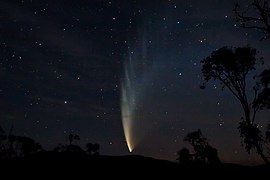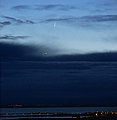Comet McNaught
From Wikipedia, the free encyclopedia
 |
|
| Discovery | |
|---|---|
| Discovery date: | August 7, 2006 |
| Alternate designations: | C/2006 P1, Comet McNaught, Great Comet of 2007 |
| Orbital characteristics A | |
| Epoch: | 2454113.2961 (January 20, 2007) |
| Perihelion distance: | 0.17075400 AU 25,544,000 km |
| Semi-major axis: | -5681.10388683 AU |
| Eccentricity: | 1.00003006 |
| Inclination: | 77.82768004° |
| Last perihelion: | January 12, 2007 |
| Next perihelion: | N/A |
Comet McNaught, also known as the Great Comet of 2007 and given the designation C/2006 P1, is a non-periodic comet discovered on August 7, 2006 by British-Australian astronomer Robert H. McNaught.[1] It was the brightest comet in over 40 years, and was easily visible to the naked eye for observers in the Southern Hemisphere in January and February 2007.
With an estimated peak magnitude of -6.0, the comet was the second brightest since 1935.[2] Around perihelion on January 12, it was visible worldwide in broad daylight. Its tail measured an estimated 35 degrees in length at its peak.[3]
Contents |
[edit] Discovery
McNaught discovered the comet in a CCD image on August 7, 2006 during the course of routine observations for the Siding Spring Survey, which searches for Near-Earth Objects that might represent a collision threat to Earth. The comet was discovered in Ophiuchus, shining very dimly at a magnitude of about +17. From August through November 2006, the comet was imaged and tracked as it moved through Ophiuchus and Scorpius, brightening as high as magnitude +9, still too dim to be seen with the unaided eye.[4] Then, for most of December, the comet was lost in the glare of the sun.
Upon recovery, it became apparent that the comet was brightening very rapidly, reaching naked-eye visibility in early January 2007. It was visible to northern hemisphere observers, in Sagittarius and surrounding constellations, until about January 13. Perihelion was January 12 at a distance of 0.17 AU. [5] This was close enough to the Sun to be observed by the space-based Solar and Heliospheric Observatory (SOHO). The comet entered SOHO's LASCO C3 camera's field of view on January 12, and was viewable on the web in near real-time. The comet exited SOHO's field of view on January 16. Due to its proximity to the sun, the Northern Hemisphere ground-based viewers had a short window for viewing, and the comet could be spotted only during bright twilight.
As it reached perihelion on January 12, it became the brightest comet since Comet Ikeya-Seki in 1965.[6] The comet was dubbed the Great Comet of 2007 by Space.com.[7] On January 13 and 14, 2007, the comet attained an estimated maximum apparent magnitude of -6.0, as reported by several observers in the Northern hemisphere.[5]
The comet was visible in daylight about 5°- 10° southeast of the sun from January 12 to 14, with a peak brightness of magnitude -5.5.[8] Perigee (closest approach to the Earth) was January 15, 2007, at a distance of 0.82 AU.[9]
After passing the sun, McNaught became visible in the Southern hemisphere. In Australia, according to Siding Spring Observatory at Coonabarabran, where the comet was discovered, it was to have reached its theoretical peak in brightness on Sunday January 14 just after sunset,[10] when it would have been visible for 23 minutes. On January 15 the comet was observed at Perth Observatory with an estimated apparent magnitude of -4.0.[5]
The comet has faded out of view. It may still be visible to a very large observatory telescope, as a very faint object near the constellation Octans.[11]
[edit] Ulysses probe
The Ulysses spacecraft made an unexpected pass through the tail of the comet on February 3, 2007. [12]. Evidence of the encounter was published on the October 1, 2007 issue of the Astrophysical Journal. Ulysses flew through McNaught's ion tail 160 million miles from the comet's core and instrument readings showed that there was "complex chemistry" in the region.
The Solar Wind Ion Composition Spectrometer (SWICS) aboard Ulysses measured the composition speed of the comet tail and solar wind, and detected unexpected ions within the comet's tail and found that it had a major impact on the surrounding solar wind. It's the first time that researchers have detected O3+ oxygen ions (atoms of oxygen with a positive charge because they have five electrons instead of eight) near a comet. This suggested that the solar wind ions, originally missing most of their electrons, picked up some of their missing electrons as they passed through McNaught's atmosphere.
Besides that, SWICS found that even at 160 million miles from the comet's nucleus, the tail had slowed the solar wind to half its normal speed. The solar wind should usually be about 435 miles per second at that distance from the Sun, but inside the comet's ion tail, it was less than 249 miles per second.
"This was very surprising to me. Way past the orbit of Mars, the solar wind felt the disturbance of this little comet. It will be a serious challenge for us theoreticians and computer modellers to figure out the physics,"
—space science professor, Michael Combi.
Prof. George Gloeckler, the principal investigator on the Solar Wind Ion Composition Spectrometer (SWICS), said the discovery was important as the composition of comets told them about conditions approximately 4.5 billion years ago when the solar system was formed.
"Here we got a direct sample of this ancient material which gives us the best information on cometary composition. We're still in the process of figuring out what it tells us. We're contributing part of the whole puzzle".
"The benefits of such an observation are important. They constrain the interactions of such comets with the Sun, including how the comets lose mass. They also examine the question of how a sudden injection of neutral and cold material interacts with hot solar-like plasmas. That occurs in other places of the universe and we were able to study it right here,"
—space science professor, Thomas Zurbuchen.
[edit] Image gallery
|
Over Iceland on January 9 |
Just after sunset from Perth, Western Australia on January 16 |
Over Perth, Western Australia at 9 p.m. on January 17 |
Seen from South Beach, Fremantle, Western Australia on January 17. The lights at the bottom are navigation lights in Gage Roads. |
|
January 18 from Pukekohe, New Zealand |
From Signal Hill, Cape Town on January 19. The silhouette of Lion's Head is visible on the left, while on the right Venus sets over the Atlantic Ocean. |
||
|
Villa Alemana Region of Valparaiso, Chile on January 20 |
from Red Hill, Canberra on January 21 |
||
|
The tail of the comet Comet McNaught was still seen in Northern hemisphere after the comet itself was long gone. The picture also shows the Moon and Venus. |
A very rare sequence of the inferior mirage of the comet set |
[edit] References and footnotes
- ^ "Report on the comet discovery and progress from Robert McNaught's homepage". http://www.mso.anu.edu.au/~rmn/C2006P1.htm. Retrieved on 2007-01-17.
- ^ "Brightest comets seen since 1935". Harvard. http://cfa-www.harvard.edu/icq/brightest.html. Retrieved on 2007-01-12.
- ^ "C/2006 P1". http://cometography.com/lcomets/2006p1.html. Retrieved on 2007-01-26.
- ^ "Kronk's Cometography - C/2006P1". http://cometography.com/lcomets/2006p1.html. Retrieved on 2007-01-17.
- ^ a b c Recent Comet Brightness Estimates
- ^ "Brightest comets seen since 1935". Harvard. http://cfa-www.harvard.edu/icq/brightest.html. Retrieved on 2007-01-12.
- ^ The Great Comet of 2007: Watch it on the Web Yahoo News, January by Joe Rao of SPACE.com Skywatching Columnist. Accessed January 16, 2007
- ^ spaceweather.com
- ^ "Southern Comets Homepage". http://www.yp-connect.net/~mmatti/. Retrieved on 2007-01-17.
- ^ Siding Spring Survey
- ^ P1 magnitude plot
- ^ "A chance encounter with a comet". Astronomy. October 2, 2007. http://www.astronomy.com/asy/default.aspx?c=a&id=6065.
[edit] External links
| Wikimedia Commons has media related to: Comet McNaught |
- McNaught, Robert (2007). "C/2006 P1". Siding Springs Observatory. Australian National University. http://www.mso.anu.edu.au/~rmn/C2006P1.htm. Retrieved on 2007-01-21.
- Info and gallery, from skytonight
- Comet McNaught in Perth skies
- NASA JPL Small-Body Database Browser on C/2006 P1
- Current hotshots of comet, from NASA's Solar and Heliospheric Observatory website
- Animation of recent images within LASCO C3's FOV
- McNaught in STEREO HI1a
- Montage McNaught in STEREO HI1a
- Comet McNaught photo gallery from Southern Hemisphere
- NASA Astronomy Pictures of the Day:
- January 5 - Comet McNaught Heads for the Sun
- January 9 - McNaught Now Brightest Comet in Decades
- January 13 - Comet Over Krakow
- January 15 - Comet McNaught Over Catalonia
- January 17 - Comet McNaught from New STEREO Satellite
- January 18 - Southern Comet
- January 19 - McNaught's Matinee
- January 20 - SOHO: Comet McNaught Movie
- January 22 - The Magnificent Tail of Comet McNaught
- January 24 - A Comet Tail Horizon
- February 1 - A Tail of Two Hemispheres
- February 5 - Comet Between Fireworks and Lightning
- February 12 - Comet McNaught Over New Zealand














